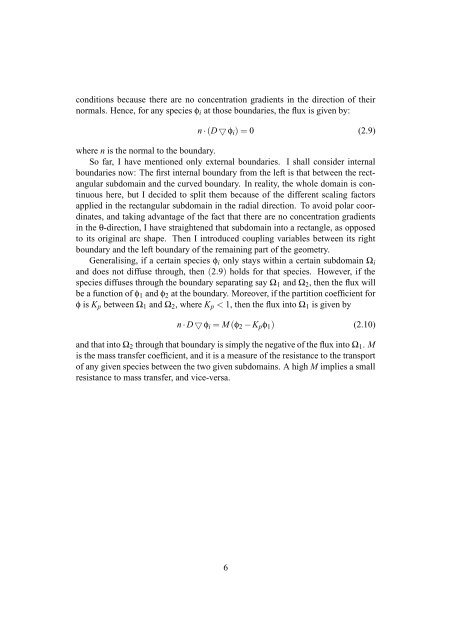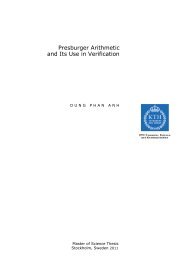FEMLAB - KTH
FEMLAB - KTH
FEMLAB - KTH
You also want an ePaper? Increase the reach of your titles
YUMPU automatically turns print PDFs into web optimized ePapers that Google loves.
conditions because there are no concentration gradients in the direction of their<br />
normals. Hence, for any species φi at those boundaries, the flux is given by:<br />
n · (D ▽ φi) = 0 (2.9)<br />
where n is the normal to the boundary.<br />
So far, I have mentioned only external boundaries. I shall consider internal<br />
boundaries now: The first internal boundary from the left is that between the rectangular<br />
subdomain and the curved boundary. In reality, the whole domain is continuous<br />
here, but I decided to split them because of the different scaling factors<br />
applied in the rectangular subdomain in the radial direction. To avoid polar coordinates,<br />
and taking advantage of the fact that there are no concentration gradients<br />
in the θ-direction, I have straightened that subdomain into a rectangle, as opposed<br />
to its original arc shape. Then I introduced coupling variables between its right<br />
boundary and the left boundary of the remaining part of the geometry.<br />
Generalising, if a certain species φi only stays within a certain subdomain Ωi<br />
and does not diffuse through, then (2.9) holds for that species. However, if the<br />
species diffuses through the boundary separating say Ω1 and Ω2, then the flux will<br />
be a function of φ1 and φ2 at the boundary. Moreover, if the partition coefficient for<br />
φ is Kp between Ω1 and Ω2, where Kp < 1, then the flux into Ω1 is given by<br />
n · D ▽ φi = M (φ2 − Kpφ1) (2.10)<br />
and that into Ω2 through that boundary is simply the negative of the flux into Ω1. M<br />
is the mass transfer coefficient, and it is a measure of the resistance to the transport<br />
of any given species between the two given subdomains. A high M implies a small<br />
resistance to mass transfer, and vice-versa.<br />
6

















